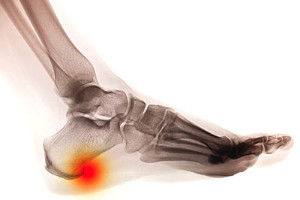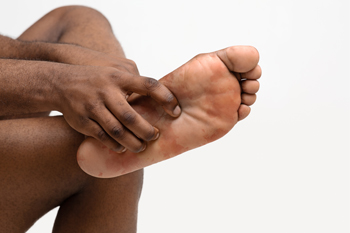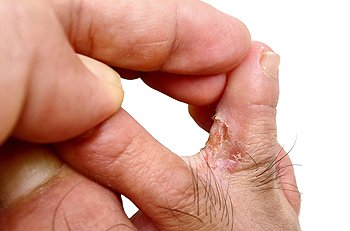
Calcaneal spurs, also known as heel spurs, are bony protrusions that form on the underside of the heel bone, which is the calcaneus. These spurs develop in response to long-term inflammation and tension on the plantar fascia, a band of tissue that connects the heel bone to the toes. The repetitive stress and strain can lead to the formation of calcium deposits, resulting in the development of bony growth. Individuals with calcaneal spurs often experience symptoms such as sharp pain in the heel, particularly during weight-bearing activities like walking or standing. The pain may intensify with the first steps in the morning or after prolonged periods of rest. Additionally, tenderness and swelling around the affected area are common. While some people with calcaneal spurs may not experience any symptoms, others may find the pain debilitating, impacting their daily activities. If you have heel pain, it is strongly suggested that you visit a podiatrist who can accurately diagnose and treat heel spurs.
Heel spurs can be incredibly painful and sometimes may make you unable to participate in physical activities. To get medical care for your heel spurs, contact one our our podiatrists from Newtown Comprehensive Foot Care. Our doctors will do everything possible to treat your condition.
Heels Spurs
Heel spurs are formed by calcium deposits on the back of the foot where the heel is. This can also be caused by small fragments of bone breaking off one section of the foot, attaching onto the back of the foot. Heel spurs can also be bone growth on the back of the foot and may grow in the direction of the arch of the foot.
Older individuals usually suffer from heel spurs and pain sometimes intensifies with age. One of the main condition's spurs are related to is plantar fasciitis.
Pain
The pain associated with spurs is often because of weight placed on the feet. When someone is walking, their entire weight is concentrated on the feet. Bone spurs then have the tendency to affect other bones and tissues around the foot. As the pain continues, the feet will become tender and sensitive over time.
Treatments
There are many ways to treat heel spurs. If one is suffering from heel spurs in conjunction with pain, there are several methods for healing. Medication, surgery, and herbal care are some options.
If you have any questions feel free to contact our office located in Newtown, CT . We offer the latest in diagnostic and treatment technology to meet your needs.

Erythromelalgia, a rare disorder that primarily affects the feet, casts a shadow over the lives of those afflicted. It is thought to occur as a result of the dysfunction of certain blood vessels that may lead to abnormal blood flow affecting the feet. In this condition, the feet endure excruciating pain and inflammation, often described as burning, stabbing, or throbbing sensations. Despite its rarity, erythromelalgia's effects are profound, disrupting daily routines and causing immense discomfort. Affected individuals may find solace only in cooling measures, as warmth exacerbates symptoms. The distinctive symptom of this disorder lies in the visible manifestation on the feet, which is a striking redness and warmth, similar to a fiery glow, that distinguishes it from other ailments. Walking, standing, or even wearing shoes become arduous tasks, imposing significant limitations on mobility and quality of life. Understanding the nuances of erythromelalgia is imperative, shedding light on its silent but profound impact on the feet and the lives it touches. If you or someone you know is affected by this rare foot disease, it is strongly suggested that you are under the care of a podiatrist who can help you manage this painful condition.
Some foot conditions may require additional professional care. If you have any concerns, contact one our our podiatrists of Newtown Comprehensive Foot Care. Our doctors can provide the care you need to keep you pain-free and on your feet.
Rare Foot Conditions
The majority of foot conditions are common and can be treated by a podiatrist. Standard diagnostic procedures are generally used to identify specific conditions and treatment can be rendered. A podiatrist also treats rare foot conditions which can be difficult to diagnose and may need extra attention and care.
There are many rare foot conditions that can affect children. Some of these can include:
- Freiberg’s disease
- Kohler’s disease
- Maffucci syndrome
Freiberg’s disease - This can be seen as a deterioration and flattening of a metatarsal bone that exists in the ball of the foot. It typically affects pre-teen and teenage girls, but can affect anyone at any age. Symptoms that can accompany this can be swelling, stiffness, and the patient may limp.
Kohler’s disease - This often targets the bone in the arch of the foot and affects younger boys. It can lead to an interruption of the blood supply which ultimately can lead to bone deterioration. The patient may limp or experience tenderness, swelling, and redness.
Maffucci syndrome - This affects the long bones in a child’s foot leading to the development of abnormal bone lesions. They are benign growths and typically develop in early childhood and the bones may be susceptible to breaking.
A podiatrist can properly diagnose and treat all types of rare foot conditions. If your child is affected by any of these symptoms or conditions, please don’t hesitate to call our office so the correct treatment method can begin.
If you have any questions please feel free to contact our office located in Newtown, CT . We offer the newest diagnostic tools and technology to treat your foot and ankle needs.

Athlete's foot, a fungal infection affecting the skin of the feet, is often closely intertwined with hygiene practices. Fungi thrive in warm, moist environments, making sweaty socks and tight shoes ideal breeding grounds. Poor foot hygiene, such as infrequent washing or drying between toes, exacerbates the risk of infection. Additionally, walking barefoot in shared spaces like gym showers or swimming pools increases exposure to the fungus. Athletes, hence the name, are particularly susceptible due to prolonged periods of sweaty feet and communal locker rooms. Symptoms include itching, burning, and cracked skin, often between the toes or on the soles of the feet. Fortunately, maintaining good foot hygiene can help prevent athlete's foot. Regularly wash and thoroughly dry feet, especially between the toes, and wear clean, breathable socks and shoes, it is helpful to avoid sharing footwear or walking barefoot in public areas. If you have developed athlete’s foot, it is suggested that you visit a podiatrist who can offer you effective medication for treatment.
Athlete’s Foot
Athlete’s foot is often an uncomfortable condition to experience. Thankfully, podiatrists specialize in treating athlete’s foot and offer the best treatment options. If you have any questions about athlete’s foot, consult with one our our podiatrists from Newtown Comprehensive Foot Care. Our doctors will assess your condition and provide you with quality treatment.
What Is Athlete’s Foot?
Tinea pedis, more commonly known as athlete’s foot, is a non-serious and common fungal infection of the foot. Athlete’s foot is contagious and can be contracted by touching someone who has it or infected surfaces. The most common places contaminated by it are public showers, locker rooms, and swimming pools. Once contracted, it grows on feet that are left inside moist, dark, and warm shoes and socks.
Prevention
The most effective ways to prevent athlete’s foot include:
- Thoroughly washing and drying feet
- Avoid going barefoot in locker rooms and public showers
- Using shower shoes in public showers
- Wearing socks that allow the feet to breathe
- Changing socks and shoes frequently if you sweat a lot
Symptoms
Athlete’s foot initially occurs as a rash between the toes. However, if left undiagnosed, it can spread to the sides and bottom of the feet, toenails, and if touched by hand, the hands themselves. Symptoms include:
- Redness
- Burning
- Itching
- Scaly and peeling skin
Diagnosis and Treatment
Diagnosis is quick and easy. Skin samples will be taken and either viewed under a microscope or sent to a lab for testing. Sometimes, a podiatrist can diagnose it based on simply looking at it. Once confirmed, treatment options include oral and topical antifungal medications.
If you have any questions, please feel free to contact our office located in Newtown, CT . We offer the newest diagnostic and treatment technologies for all your foot care needs.

